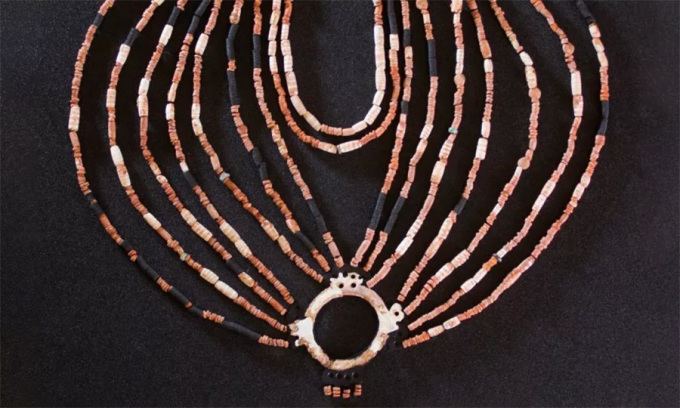Jordan The necklace, made of multiple strands and made from more than 2,500 stones and shell fragments, suggests the child in the grave had a high social status.

A physical reconstruction of a 9,000-year-old necklace on display at the Petra Museum in Jordan. Photo: Alarashi/PLOS One
European researchers have reconstructed an elaborate necklace buried with an 8-year-old child in a tomb in the village of Ba'ja, Jordan, dating back to around 7400-6800 BC, during the Neolithic period. The Neolithic is an archaeological period that began in the Middle East at least as early as the 10th millennium BC. The reconstruction is described in a new study published in the journal PLOS One on August 2.
Ba'ja is one of the most important and well-studied villages in the Neolithic Southern Levant. Since 1997, archaeological research at Ba'ja has revealed large, deep, and complex structures.
The tomb was discovered in 2018, containing the remains of a child in a fetal position, along with more than 2,500 colorful stones and shell fragments on the chest and neck, a perforated stone pendant, and an intricately carved mother-of-pearl ring.
Through analysis of the composition, manufacture, and distribution of the artifacts, the team concluded that they were part of a necklace made of several strings of beads. "Through multiple lines of evidence, we believe that the necklace was made in Ba'ja, although the significant shell and stone components came from elsewhere, including fossilized amber," the team wrote.
The necklace suggests the tomb's owner had an important social status, the team said. "Ornaments with such a large number of beads - more than 2,500 - are unprecedented in Neolithic villages in the Levant," the team said.
The team recreated a physical version of the original necklace, which is now on display at the Petra Museum in Jordan. Because the necklace was not in its original location when it was discovered, the reconstruction had to rely on extensive analysis and a series of estimates based on logical guesses.
“The reconstruction exceeded our expectations, revealing an impressive multi-chain necklace with complex structure and eye-catching design,” the team said. This is one of the oldest and most impressive examples of Neolithic ornamentation, and sheds light on burial practices for high-status individuals.
According to experts, the newly discovered necklace is unlike any other Neolithic decorative tradition of the Levant known to date. Its large size, complex structure, symmetry, harmony, beauty of the objects and colors are reminiscent of the elaborate decorations of later Egyptian and Mesopotamian societies.
The making of the necklace required skilled craftsmanship and the importation of some exotic materials from other regions, highlighting the high level of connection between the ancient Ba'ja people and the wider world .
Thu Thao (According to Newsweek )
Source link




































































































Comment (0)